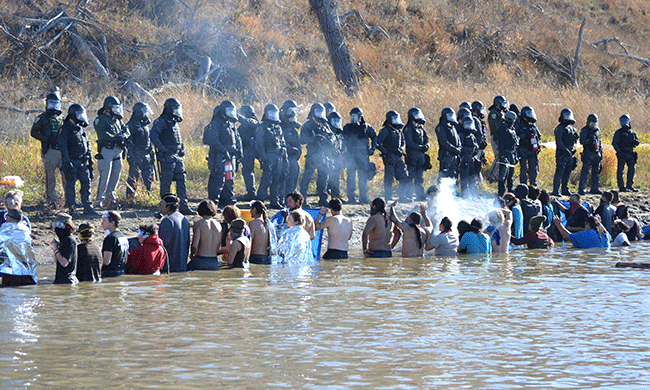The White Horse and the Humvees—Standing Rock Is Offering Us a Choice

Standing Rock water protector. Photo by Adam Alexander Johansson.
Two lines, facing each other on a North Dakota highway. On one side, concrete barriers protect a row of armored vehicles and helmeted police with assault rifles. On the other, a young man rides a white horse whose legs are stained with blood. A woman, wearing a scarf to protect her lungs from tear gas, wafts sage smoke over a boy to give him strength, wash away hate, and remind him of his sacred purpose.
Here, on a highway stretching across trampled prairie grass, the fundamental contest of our time is playing out.
The fundamental contest of our time is playing out.
It’s a confrontation not only between two groups of people, but between two world views. The space between the lines vibrates with tensions of race, historical trauma, broken treaties, money and politics, love and fear. But the underlying issue that charges the air, mixing with the smells of tear gas and sage, is the global contest between two deeply different ideas about the true meaning of land.
On one side is the unquestioned assumption that land is merely a warehouse of lifeless materials that have been given to (some of) us by God or conquest, to use without constraint. On this view, human happiness is best served by whatever economy most efficiently transforms water, soils, minerals, wild lives, and human yearning into corporate wealth. And so it is possible to love the bottom line on a quarterly report so fiercely that you will call out the National Guard to protect it.
On the other side of the concrete barriers is a story that is so ancient it seems revolutionary. On this view, the land is a great and nourishing gift to all beings. The fertile soil, the fresh water, the clear air, the creatures, swift or rooted: they require gratitude and veneration. These gifts are not commodities, like scrap iron and sneakers. The land is sacred, a living breathing entity, for whom we must care, as she cares for us. And so it is possible to love land and water so fiercely you will live in a tent in a North Dakota winter to protect them.
It may turn out that the cracks in that stretch of two-lane highway mark a giant crack in time, when one set of assumptions about reality snaps and is replaced by another. This, like all times of paradigm shift, is an unsettled time, a time of shouting and police truncheons, as privileged people defend the assumptions that have served them royally.
What are they so afraid of out there in North Dakota, that they arrest journalists, set dogs on women and children, send prayerful protectors to jail and align para-military force against indigenous people on their own homelands?
Everyone can join the people of Standing Rock and say No.
Maybe they are afraid of the truth-telling power of the people at Standing Rock and their busloads of allies, who are making clear that we live in an era of profound error that we mistakenly believe is the only way we can live, an era of insanity that we believe is the only way we can think. But once people accept with heart and mind that land is our teacher, our mother, our garden, our pharmacy, our church, our cradle and our grave, it becomes unthinkable to destroy it. This vision threatens the industrial worldview more than anything else.
Indigenous people are saying, there are honorable and enduring lifeways that beckon to people who are weary of destruction.
Everyone can join the people of Standing Rock and say No. No more wrecked land. No more oil spills. No more poisoned wells. We don’t have to surrender the well-being of communities to the profit of a few. We can say Yes. Yes, we are all in this together. Yes, we can all stand on moral ground. Yes, we can all be protectors of the water and protectors of the silently watching future. The blockade on the highway is an invitation to remember and reclaim who we might be — just and joyous humans on a bountiful Earth. Right here, between the barricades, we are offered a choice.
On the highway, a warrior steps around the concrete barrier, offering a sage bundle that trails white smoke. Approaching a figure in riot gear, he extends the blessing to the officer, letting the smoke wash over him. To give him strength. To wash away hate. To remind him of his purpose.

|
Robin Wall Kimmerer is a mother, scientist, decorated professor, and enrolled member of the Citizen Potawatomi Nation. She is the author of Braiding Sweetgrass: Indigenous Wisdom, Scientific Knowledge and the Teachings of Plants, which has earned Kimmerer wide acclaim. Her first book, Gathering Moss: A Natural and Cultural History of Mosses, was awarded the John Burroughs Medal for outstanding nature writing, and her other work has appeared in Orion, Whole Terrain, and numerous scientific journals. As a writer and a scientist, her interests in restoration include not only restoration of ecological communities, but restoration of our relationships to land. She holds a BS in Botany from SUNY ESF, an MS and PhD in Botany from the University of Wisconsin and is the author of numerous scientific papers on plant ecology, bryophyte ecology, traditional knowledge and restoration ecology.
|





